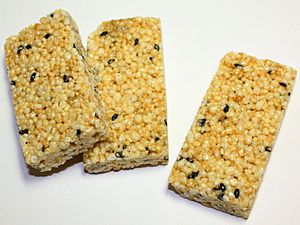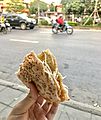Millet facts for kids
Millet is a type of grain that people eat. There are many kinds of millet.
Millet is quite nutritious. It has about three grams of protein and one gram of fiber in half a serving. It also contains iron. Millets have a lot of fiber, but some of their nutrients can be a bit harder for the body to use. This can make them less popular for some people.
Millet as Food
Millets are a main food source in dry and semi-dry parts of the world. They are also a big part of traditional meals in many other places. In western India, a grain called sorghum is often used with millet flour. People use this mix to make flatbreads like rotla or bhakri. Other millets, like ragi (finger millet), are also popular. For example, ragi rotti and Ragi mudde are common meals in Karnataka, India. Ragi looks dark, like rye, but has a rougher feel.
Millet porridge is a traditional dish in Russia, Germany, and China. In Russia, people eat it sweet with milk and sugar. They also eat it savory with meat or vegetable stews. In China, it's often eaten without milk or sugar, sometimes with beans, sweet potato, or different kinds of squash. In Germany, it's eaten sweet, cooked with apples, and then honey is added.
People in Western Africa eat a lot of millet. In countries like Burkina Faso, Chad, and Gambia, millet makes up about 35% of all the cereal grains people eat. In Mali and Senegal, it's about 40%. In Niger and dry Namibia, it's even more, over 65%. Other African countries where millet is an important food include Ethiopia, Nigeria, and Uganda. Millet is also a key food for people in dry areas of China, India, Burma, and North Korea.
Between the 1970s and 2000s, people started eating less millet. This happened as developing countries like India grew richer. People began to eat more of other types of grains instead.
Millet for Special Diets
People who cannot eat gluten, such as those with coeliac disease or wheat allergy, can eat millet. Millet itself does not contain gluten. However, millet grains and flour might sometimes get mixed with other grains that do have gluten. So, it's important to be careful.
Millet is also a common ingredient in seeded bread. It is also used to feed birds and other animals.
Millet for Animals
Besides being used for its seeds, millet is also grown as a crop for animals to graze on. Instead of letting the plant fully grow, farmers let animals like sheep and cattle eat it.
Millet is a special kind of plant called a C4 plant. This means it uses water very well and grows best in warm weather. Because of this, it's a good summer crop.
In southern Australia, millet is used as a good summer pasture. It uses the warm temperatures and summer rain. Millet is sensitive to frost. Farmers plant it after the frost season, when the soil is warm enough. They plant it shallowly.
Millet grows quickly. Animals can start grazing on it 5–7 weeks after it's planted, when it's about 20–30 cm tall. The best food value comes from the young green leaves and shoots. The plant can quickly grow its seed heads. Farmers need to manage it well because as the plant gets older, its food value and how much animals like to eat it goes down.
Japanese millets are thought to be the best for grazing. A new type called Shirohie is especially good. It grows back well and takes longer to mature than other Japanese millets. It's also cheap to plant and grows quickly. It can be grazed early and is good for both sheep and cattle.
Compared to forage sorghum, which is another grazing crop, animals gain weight faster on millet. Millet is also better for making hay or silage, even though it produces less dry plant material. Lambs do better on millet than on sorghum. Millet does not have a harmful substance called prussic acid, which can be found in sorghum. Prussic acid can make animals sick by stopping their bodies from using oxygen properly. With millet, animals usually don't need extra food supplements like sulphur or salt blocks.
Millet's fast growth as a grazing crop gives farmers flexibility. They can wait for enough rain in late spring or summer and then plant it. It's also great for irrigated farms where animals need to gain weight quickly.
Images for kids
-
Pearl millet in the field
-
Finger millet in the field
-
Sprouting millet plants
-
Bánh đa kê, a special snack from Hanoi
See also
 In Spanish: Mijo para niños
In Spanish: Mijo para niños






